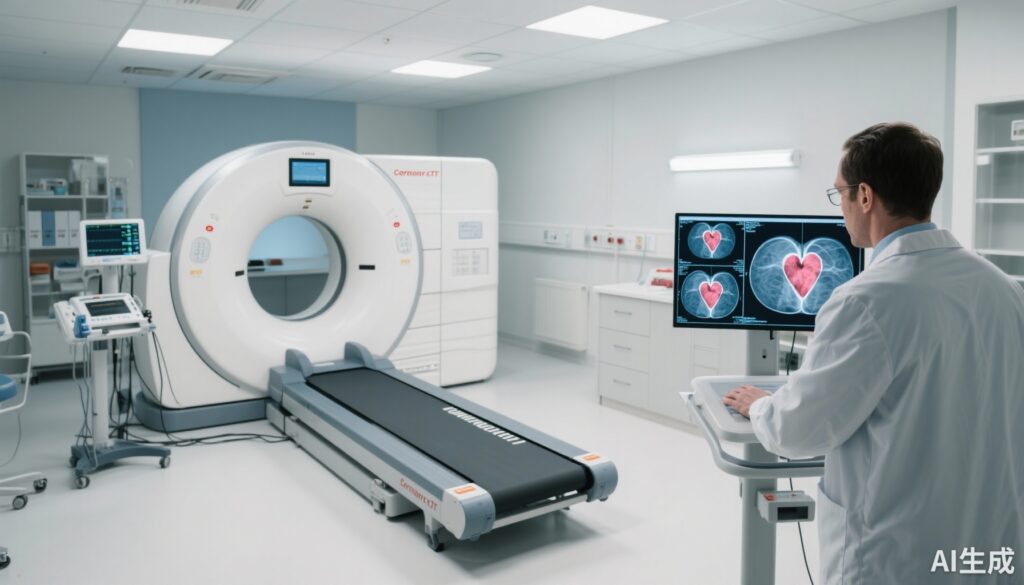Highlight
- In stable symptomatic patients with suspected coronary artery disease (CAD), initial testing with either functional stress testing or anatomic coronary computed tomographic angiography (CTA) showed no difference in 10-year all-cause mortality.
- Cardiovascular mortality trends favored coronary CTA but did not reach statistical significance.
- Coronary CTA findings of any abnormality, even mild nonobstructive CAD, strongly predicted higher mortality risk, while only severe abnormalities on stress testing significantly predicted mortality.
- Use of guideline-directed medical therapies (statins, β-blockers, antiplatelets) did not modify mortality outcomes by initial testing strategy.
Study Background and Disease Burden
Coronary artery disease (CAD) remains a leading cause of morbidity and mortality worldwide. Patients presenting with symptoms such as chest pain or dyspnea frequently undergo noninvasive testing to evaluate for CAD. Two principal diagnostic strategies are commonly employed: functional assessment via stress testing (exercise or pharmacologic) and anatomic visualization through coronary computed tomographic angiography (CTA). Each method offers unique insights—stress testing assesses myocardial ischemia, while CTA delineates coronary artery anatomy and plaque burden. Current clinical guidelines endorse both approaches but have uncertain long-term prognostic implications for initial test selection. The PROMISE (Prospective Multicenter Imaging Study for Evaluation of Chest Pain) trial prospectively randomized symptomatic patients to initial CTA versus stress testing, providing a valuable dataset to compare long-term outcomes in these diagnostic arms. Given that symptom evaluation for suspected CAD represents a high-volume clinical scenario, understanding whether the initial choice of testing impacts survival and cardiovascular events informs both patient management and health resource allocation.
Study Design
This analysis reports extended follow-up outcomes from the PROMISE randomized controlled trial conducted between 2009 and 2014 at 193 multispecialty outpatient sites across North America. A total of 10,003 symptomatic patients with suspected CAD underwent randomization in a 1:1 fashion to either initial coronary CTA or functional stress testing, with subsequent management left to physician discretion per usual care.
The current 2025 analysis uses the 2024 National Death Index to ascertain mortality, extending the median follow-up to 10.6 years (IQR: 9.9–11.3 years), with a maximum follow-up of 12.4 years.
The original PROMISE primary endpoint was a composite of all-cause death, myocardial infarction, hospitalization for unstable angina, or major procedural complications. For this extended follow-up, the primary endpoint was all-cause death, with cardiovascular mortality as a secondary endpoint.
Key Findings
At baseline, the mean age of participants was 61 years, with a slight female predominance (52.7%). Most patients (87.6%) presented with chest pain or dyspnea. Over the follow-up period, 1,128 deaths occurred (14.4%), split nearly equally between the CTA arm (14.3%) and stress testing arm (14.5%). The unadjusted hazard ratio (HR) for all-cause mortality comparing CTA to stress testing was 0.98 (95% CI, 0.87–1.10), indicating no significant survival difference.
Cardiovascular mortality showed a nonsignificant trend favoring CTA with an HR of 0.84 (95% CI, 0.67–1.05) unadjusted, and an adjusted HR of 0.89 (95% CI, 0.41–1.94), suggesting a possible but inconclusive benefit of anatomic imaging.
Subgroup analyses revealed no significant interactions between testing strategy and age (<60 or ≥60 years), gender, or race/ethnicity on all-cause or cardiovascular mortality.
Importantly, coronary CTA results identifying any level of coronary abnormality—including mild nonobstructive CAD, moderate, or severe disease—were associated with substantially increased adjusted hazard ratios for death, ranging from 1.99 to 3.44 (P < .001) compared to normal CTA findings. In contrast, among stress testing results, only severe abnormalities conferred a significant mortality risk increase (HR, 1.45; 95% CI, 1.10–1.91).
Landmark analyses of those surviving beyond 90 days found no significant interactions between test modality and use of statins (interaction P = .22), β-blockers (P = .76), or antiplatelet agents (P = .49) on mortality outcomes.
This extended follow-up analysis underscores the robust prognostic information conveyed by CTA-detected coronary abnormalities, even when nonobstructive, compared with functional testing abnormalities that require a higher threshold of severity to impact survival.
Expert Commentary
The PROMISE trial’s extended data solidify an important paradigm: the initial choice between functional stress testing and anatomic coronary CTA for stable symptomatic patients with suspected CAD does not influence all-cause or cardiovascular mortality over a decade. This finding aligns with prior shorter-term analyses and informs clinical decision-making based on patient preferences, clinical presentation, availability, and cost considerations rather than survival benefit.
From a mechanistic standpoint, CTA’s sensitivity to detect early atherosclerosis—including nonobstructive plaques—enables more refined risk stratification. This may explain why any abnormality on CTA correlated with mortality, whereas only severe ischemia on stress testing showed prognostic significance. Nevertheless, this improved risk stratification did not translate into survival differences based on initial testing strategy, suggesting subsequent clinical management and secondary prevention therapies play critical roles.
Limitations include the pragmatic design permitting treating physicians to tailor management post-testing, potentially diluting survival impact differences attributable solely to test choice. Moreover, generalizability to populations with different demographics or symptom profiles should be considered cautiously.
The absence of interaction between pharmacotherapy (statins, β-blockers, antiplatelets) and test modality on mortality emphasizes that evidence-based secondary prevention remains paramount regardless of initial diagnostic approach.
Conclusion
In symptomatic patients evaluated for suspected coronary artery disease, initial noninvasive testing using either functional stress testing or anatomic coronary CTA yields equivalent 10-year survival. The prognostic strength of CTA-detected coronary abnormalities highlights its utility in risk stratification but does not confer a mortality advantage when chosen as the initial test. Clinical decisions on testing should thus integrate patient factors, local expertise, and resource considerations without concern for compromising long-term survival. Further research might explore how integrating anatomic and functional testing strategies, or targeted therapies informed by CTA findings, could impact clinical outcomes beyond diagnosis.
References
1. Douglas PS, Stebbins A, Foldyna B, et al. Survival After Initial Stress Testing vs Anatomic Testing in Suspected Coronary Artery Disease: Long-Term Follow-Up of the PROMISE Randomized Clinical Trial. JAMA Cardiol. 2025 Aug 27:e252882. doi:10.1001/jamacardio.2025.2882.
2. Writing Committee Members, et al. 2021 AHA/ACC Guideline for the Evaluation and Diagnosis of Chest Pain. Circulation. 2021;144:e368-e454.
3. Min JK, et al. Prognostic Value of Coronary Computed Tomographic Angiography. J Am Coll Cardiol. 2019;73(18):2242–2258.


